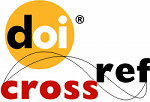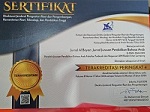The Development of Assessment Rubric of Arabic Language Writing Based on National Qualifications Framework of Indonesia
Abstract
National qualifications framework of Indonesia needed to be technically elaborated and more operational (KKNI). Academic writing at the university level is difficult to measure without using a rubric. One form of this technique was the creation of an assessment rubric. This article aimed to develop an assessment instrument in the form of a rubric that focused on Arabic academic writing skills for undergraduate students based on the KKNI. The development research method was used with a convergent parallel mixed method model. The data were taken from three tertiary institutions consisting of 1 state university and 2 private universities. Data in the form of needs analysis results, expert analysis, and rubric reliability test results. The results of the trial were compared with the one group pre-test post-test experimental technique to prove that the rubric developed was feasible and reliable for use in teaching Arabic academic writing. The trial process proved that this rubric was feasible to use. Based on the results of the T test, a result of 0.000 (p <0.05) was obtained. The results of the pretest and posttest experienced significant changes. It could be concluded that the Arabic academic writing rubric based on KKNI that was tested in the UHAMKA, UNJ, and UMSIDA. Arabic Education Study Programs was effective in Arabic academic writing tests. The result of the research was a rubric that can be used for Arabic academic writing in universities. This result was significant to be implemented especially for teachers and lecturers in Arabic writing fields.
Keywords
Full Text:
PDFReferences
Altınmakas, Derya, and Yasemin Bayyurt. “An Exploratory Study on Factors Influencing Undergraduate Students’ Academic Writing Practices in Turkey.” Journal of English for Academic Purposes 37, (2019): 88–103
Arifa, Zakiyah. “Strategi Sukses Atasi Problem Menulis Akademik Bahasa Arab.” Gontornews. 2019.
Arifin, Zamri, and Zainuddin Ismail. “Arabic Speaking Skills as a PBJJ Course: Between Objectives and Reality.” Procedia - Social and Behavioral Sciences 18, (2011): 534–536
Bacha, Nahla N. “Developing Learners’ Academic Writing Skills in Higher Education: A Study for Educational Reform.” Language and Education 16, no. 3 (2010): 161–177
Boeriswati, Endry. “The Implementing Model of Empowering Eight for Information Literacy.” US-China Education Review 7, (2012): 650–661
Brown, H.Douglas. Teaching by Principles an Interactive Approach to Language Pedagogy, Teaching by Principles An Interactive Approach to Language Pedagogy (Pearson ESL, 2000)
Chowdhury, Faieza. “Application of Rubrics in the Classroom: A Vital Tool for Improvement in Assessment, Feedback and Learning.” International Education Studies 12, no. 1 (2018): 61-68
Dasopang, Wahyuni Apriliani, Muhammad Alpin Hascan, Dita Ayu, and R Pratiwi. “Problematika Mahasiswa terhadap Tugas Perkuliahan Berbasis Kurikulum KKNI (Studi Kasus Prodi PAI UIN Sumatera Utara).” Risalah: Jurnal Pendidikan dan Studi Islam 8, no. 1 (2022): 20–34 .
Dick, Walter, Lou Carey, and James O. Carey. The Systematic Design of Instruction, Eighth Edi. Boston: Pearson Education, 2015.
Fahmi, Ari Khairurrijal. “Analisis Kesalahan Gramatikal Teks Terjemah (Indonesia-Arab) dalam Pendidikan Bahasa Arab.” Kordinat: Jurnal Komunikasi antar Perguruan Tinggi Agama Islam 15, no. 1 (2016): 105–116.
Fahrurrozi, Aziz. “Pembelajaran Bahasa Arab: Problematika dan Solusinya.” Arabiyat : Jurnal Pendidikan Bahasa Arab dan Kebahasaaraban 1, no, 2 (2014): 161–179
Glass, Kathy Tuchman. Curiculum Design for Writing Instruction. London: Sage Publication, 2005.
Hakim, Muhammad Kamal Abdul. “Improving Arabic Academic Writing Skills Through Contextual Teaching And Learning Approach.” Alsinatuna 3, no. 2 (2018): 183-199
Hartik, S., Sri Utaminingsih, and Ahmad Hilal Madjdi. “A Need Assessment of Integrated Science Teaching Material Based Higher Order Thinking Skills (HOTS).” Journal of Physics: Conference Series 1823, no. 1 (2021): 012078
Helaluddin, and Awalluddin. Keterampilan Menulis Akademik : Panduan bagi Mahasiswa di Perguruan Tinggi. Serang. 2020.
Henderson, Kathryn I. “Teacher Language Ideologies Mediating Classroom-Level Language Policy in the Implementation of Dual Language Bilingual Education.” Linguistics and Education, Science Direct 13, (2017).
Hikmat Ade, Solihati Nani, Riadi Sugeng. Penulisan Akademik, 1st edn (Bekasi: Paedea, 2020)
Jeong, Heejeong. “Rubrics in the Classroom: Do Teachers Really Follow Them?.” Language Testing in Asia 5, no. 1 (2015): 1-14.
Mahmudi, Arifka. “The Use of G-Form as an Assessment Instrument in Arabic Language Teaching Based on HOTS.” At-Tarbawi: Jurnal Kajian Kependidikan Islam 3, no. 2 (2018)
Mckimm, Judy, Carol Jollie, and Peter Cantillon. ABC of Learning and Teaching Web Based Learning, 2003
Michel, Marije, Judit Kormos, Tineke Brunfaut, and Michael Ratajczak. “The Role of Working Memory in Young Second Language Learners’ Written Performances.” Journal of Second Language Writing 45, (2019): 31–45.
Najjar, Muhammad Rajab. Al-Kitabah al-'Arabiyyah Maharatiha wa Fununaha (Kuwait: Maktabah Darul Uruubah Linnasyri wat Tauzi’, 2001).
Ozfidan, Burhan, and Connie Mitchell. “Assessment of Students’ Argumentative Writing: A Rubric Development.” Journal of Ethnic and Cultural Studies 9, no 2 (2022): 121–33
Pamessangi, Andi Arif. “Analisis Kesulitan Belajar Bahasa Arab Mahasiswa Program Studi Pendidikan Bahasa Arab Iain Palopo.” Al Ibrah: Journal of Arabic Languange Education 2, (2019): 2622–6006.
Quintero, Elsa Fernanda González, Nelly Paulina Trejo Guzmán, and Ruth Roux Guzmán. “Assessing EFL University Students’ Writing: A Study of Score Reliability.” Revista Electronica de Investigacion Educativa, 19 (2017), 91–103
Rahayu, Wardani, Muhammad Dwirifqi Kharisma Putra, Faturochman, Meiliasari, Erwin Sulaeman, and Rekha B. Koul. “Development and Validation of Online Classroom Learning Environment Inventory (OCLEI): The Case of Indonesia during the COVID-19 Pandemic.” Learning Environments Research 25, no. 1 (2022): 97-113
Sahrir, Muhammad Sabri, and Nor Aziah Alias. “A Design and Development Approach to Researching Online Arabic Vocabulary Games Learning in IIUM.” Procedia - Social and Behavioral Sciences 67, (2012): 360–369
Setiadi, Syamsi. “Peningkatan Keterampilan Kitabah Arabiyah Mahasiswamelalui Metode Tutor Sebaya.” Jurnal Al Bayan: Jurnal Jurusan Pendidikan Bahasa Arab 9, no. 1 (2017): 31-39,
Shen, Bin, Barry Bai, and Weihe Xue. “The Effects of Peer Assessment on Learner Autonomy: An Empirical Study in a Chinese College English Writing Class.” Studies in Educational Evaluation 64, (2020): 1–10
Silvestri, Lynette, and Jeffrey Oescher. “Using Rubrics to Increase the Reliability of Assessment in Health Classes.” International Electronic Journal of Health Education 9, (2006): 25–30.
Susilawati, Susilawati, Jamalludin Rahmat, and Agus Riyan Oktori. “Implementasi Kurikulum Berbasis KKNI dalam Upaya Penguatan Mutu Lulusan pada Program Studi PGMI IAIN Curup.” Ar-Riayah : Jurnal Pendidikan Dasar 6, no. 1 (2022): 105
Ting, Yu Liang. “Tapping into Students’ Digital Literacy and Designing Negotiated Learning to Promote Learner Autonomy.” The Internet and Higher Education 26, (2015): 25–32
Tran, Thao Trinh Thi and Huan Buu Nguyen. “The Effects of Paraphrasing on EFL Students ’ Academic Writing.” Journal of Language and Linguistic Studies 18, no. 1 (2022): 976–987
Umami, Mashlihatul. “Enhancing Students Motivation and Achievement in Learning Grammar through Contextual Teaching and Learning through Relating, Experiencing, Applying, Cooperating and Transferring (React) Strategy.” UNNES International Conference on ELTLT (English Language Teaching, Literature and Translation 4, (2015): 490–502
Wahab, Muhbib Abdul. “Standarisasi Kurikulum Pendidikan Bahasa Arab di Perguruan Tinggi Keagamaan Islam Negeri.” Arabiyat : Jurnal Pendidikan Bahasa Arab dan Kebahasaaraban 3, (2016): 32–51
Wahab, Muhbib Abdul, Aziz Fahrurrozi, Tulus Musthafa, and Syamsul Arifin. “Standarisasi Kompetensi Bahasa Arab bagi Calon Sarjana Perguruan Tinggi Keagamaan Islam Negeri.” Arabiyat : Jurnal Pendidikan Bahasa Arab dan Kebahasaaraban 5, no. 1 (2018) .
Widiastuti, Ni Putu Kusuma, Ida Bagus Putrayasa, and Komang Surya Adnyana. “Menyusun Instrument Penilaian Keterampilan Menulis Siswa Sekolah Dasar.” Jurnal Pedagogi dan Pembelajaran 5, no. 1 (2022): 50–56.
Wingate, Ursula. “Using Academic Literacies and Genre-Based Models for Academic Writing Instruction: A “literacy” Journey.” Journal of English for Academic Purposes 11, no 1 (2012): 26–37
Yanti, Nafri, Suhartono, and Fina Hiasa. “Keterampilan Menulis Akademik Mahasiswa S-1 Program Studi Pendidikan Bahasa dan Sastra Indonesia FKIP Universitas Bengkulu.” Silampari Bisa Jurnal Penelitian Pendidikan Bahasa Indonesia 1, (2018)
DOI: http://dx.doi.org/10.24042/albayan.v15i1.16302
Refbacks
- There are currently no refbacks.
Copyright (c) 2023 Jurnal Al Bayan: Jurnal Jurusan Pendidikan Bahasa Arab
License URL: https://creativecommons.org/licenses/by-nc-sa/4.0
Editorial Office:
Jurnal Al Bayan: Jurnal Jurusan Pendidikan Bahasa Arab, Arabic Education Study Program, Faculty of Education and Teachers Training, Unversitas Islam Negeri Raden Intan Lampung
Jl. Endro Suratmin 1 Sukarame, Bandar Lampung 35131-Indonesia
e-mail: jurnalalbayan@radenintan.ac.id
http://ejournal.radenintan.ac.id/index.php/albayan/index
Jurnal Al Bayan: Jurnal Jurusan Pendidikan Bahasa Arab is licensed under a Creative Commons Attribution-ShareAlike 4.0 International License. p-ISSN 2086-9282 | e-ISSN 2549-1229









